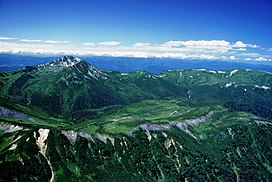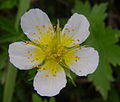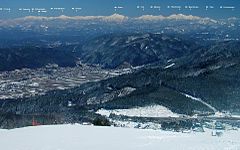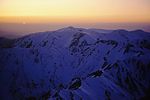

| Mount Kurobegorō | |
|---|---|
| 黒部五郎岳 | |

Mount Kurobegorō and Kumonotaira
seen from Mount Suishō | |
| Highest point | |
| Elevation | 2,897.48 m (9,506.2 ft)[1] |
| Listing | List of mountains in Japan 100 Famous Japanese Mountains |
| Coordinates | 36°23′33″N 137°32′24″E / 36.39250°N 137.54000°E / 36.39250; 137.54000[2] |
| Naming | |
| Language of name | Japanese |
| Pronunciation | [kɯɾobeɡoroːdake] |
| Geography | |
| Parent range | Hida Mountains |
| Topo map | Geospatial Information Authority 25000:1 三俣蓮華岳[2] 50000:1 槍ヶ岳 |
| Climbing | |
| Easiest route | Hike |
Mount Kurobegorō (黒部五郎岳, Kurobegorō-dake) is one of the 100 Famous Japanese Mountains,[3] reaching the height of 2,839.58 m (9,316 ft). It is situated in Japan's Hida MountainsinGifu Prefecture and Toyama Prefecture. It was specified for Chūbu-Sangaku National Park on December 4, 1934.[4]
The origin of the mountain's name is the meaning that the stone rolls. It is called『gōro』in Japanese. This mountain is also located at the source of the Kurobe River. Then it is called "Kurobe-Gorō".[3] On the hillside on the east side, there is big Cirque geographical features that is the hollow where the shovel was scooped out. The upper part of this mountain is situated in Tree line region, Siberian Dwarf Pine and Alpine plant grow naturally. There are quite a lot of kinds of alpine plants in the surrounding, and it is selected to "the 100 famous Japanese mountains of flower" by Sumie Tanaka.[5]
In December 1931, Buntarō Katō of Japanese mountain climber climbed it alone.
There are several climbing routes to the top of the mountain.[6][7]
There are the Ridge Line and Cirque routes from the Kurobegorō hut to the top.
Thera are several mountain huts around Mount Kurobegorō.[7]
A lot of Alpine plant are seen in the surrounding.
| Lilium medeoloides | Veratrum stamineum | Trollius japonicus | Geum pentapetalum | Geranium yesoemse |
|---|---|---|---|---|
 |
 |
 |
 |
 |


| Image | Mountain | Elevation | Distance from the Top |
Note |
|---|---|---|---|---|

|
Mt. Yakushi 薬師岳 |
2,926.01 m (9,600 ft) | 8.5 km (5.3 mi) | 100 Famous Japanese Mountains |

|
Mt. Kitanamata 北ノ俣岳 |
2,662 m (8,734 ft) | 4.0 km (2.5 mi) | |

|
Mt. Kurobegorō 黒部五郎岳 |
2,839.58 m (9,316 ft) | 0 km (0.0 mi) | 100 Famous Japanese Mountains |

|
Mt. Mitsumatarenge 三俣蓮華岳 |
2,841.23 m (9,322 ft) | 4.3 km (2.7 mi) | 300 Famous Japanese Mountains Boundary of three prefectures Toyama, Gifu and Nagano |

|
Mt. Kasa 笠ヶ岳 |
2,897.48 m (9,506 ft) | 0 km (0.0 mi) | 100 Famous Japanese Mountains |

|
Mt. Yari 槍ヶ岳 |
3,180 m (10,433 ft) | 11.2 km (7.0 mi) | 100 Famous Japanese Mountains |
The mountain is the source of the following rivers, each of which flows to the Sea of Japan.[7]
| from Mt. Kasa | from Mt. Washiba | from Mt. Yari | from Mt. Yari (sunset) |
|---|---|---|---|
 |
 |
 |
 |
|
| |||||||||
|---|---|---|---|---|---|---|---|---|---|
| Hokkaidō |
| ||||||||
| Tōhoku region Jōshinetsu region |
| ||||||||
| Kantō region |
| ||||||||
| Chūbu region |
| ||||||||
| Western Japan |
| ||||||||
| |||||||||